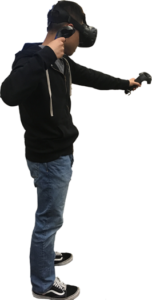A new plug-in could help video game developers personalize the level of physical activity in virtual reality (VR) games, allowing them to increase enjoyment without making players exhausted. The plug-in, created by researchers at the University of Massachusetts (UMass) Boston, uses a new approach called “exercise intensity-driven level design,” which automatically generates game levels optimized to the player’s desired physical exertion.
A member of the UMass Boston team describes its work to develop and test a plug-in for exercise intensity-driven level design
Unlike traditional console-based video games, VR games typically incorporate movement such as squatting, jumping or catching. If a game is too static, it may be less enjoyable. But if a game is too dynamic, players may quickly tire and stop playing.
“Many popular VR games today, such as those available on Steam Store, have great visuals but are exhausting to play,” said Lap-Fai (Craig) Yu, PhD, assistant computer science professor, and founder and director of the Graphics and Virtual Environments Lab at UMass Boston. “Currently, there is no approach for personalizing the level of intensity in VR game levels. Developers must evaluate physical experiences on a trial-and-error basis, which means they have to play the level, revise it, and play it again. Game balancing this way is time consuming and not scalable. Our automatic level design approach was created to ease this bottleneck.”
To use the plug-in, VR game developers divide their game level into various “chunks” of activity, such as jumping, squatting, resting, and moving left or right. They then indicate the estimated number of calories burned, the intensity, and the expected duration of each chunk. The plug-in assembles a varying number of these activity chunks and evaluates the difficulty of the level. The level is then iteratively updated until the desired amount of physical activity is reached.
The team at UMass Boston tested the plug-in by developing two games based on popular VR games available today. The first, called Reflex, was based on the Microsoft Kinect game Reflex Ridge, where players race through tracks and attempt to avoid obstacles by jumping, dodging left or right, or ducking as objects appear. The second was called Longbowman, which they developed to mimic the popular Steam VR bow shooting game Longbow. In the game, a player wearing an HTC Vive or Oculus Rift device moves two controllers to mimic the actions of pulling a bow, aiming, and shooting an arrow.

Figure 1: A player squats, jumps and catches while playing Reflex.
An initial test involved 10 healthy volunteers (five male and five female) ages 18 to 24 who played the games for five minutes each while wearing a portable heart rate monitor. The results helped the team establish expected levels of intensity, duration and calories burned for each chunk. The team then recruited an additional 21 healthy participants ages 16 to 37 who had experience using VR devices to play the optimized games. Three different levels allowed players to participate in an “easy,” “medium” or “hard” game. Players wore a portable heart rate monitor and were asked to rate their perceived level of exertion after playing the games.

Figure 2: A player shoots a target in the Longbowman game using HTC Vive controllers.
The study confirmed that the average number of calories burned by players and exercise intensity followed the target values the researchers set for each level, indicating that the plug-in successfully combined game chunks into the desired levels of intensity.
“By tracking the testers’ heart rates during the games, our approach was able to associate different gaming elements with the exercise intensity that they impose in a game level,” Dr. Yu said. “This allowed us to devise an optimization approach for automatically synthesizing game levels with respect to exercise intensity goals.”

Figure 3: To use the plug-in, game developers divide a level into chunks and set parameters for calories burned, intensity and duration. The plug-in then automatically assembles a level personalized to the player’s desired activity level.
This project was done in collaboration with Professor Tongjian You, who is a sports medicine expert, from the Department of Exercise and Health Sciences at UMass Boston. As VR and motion-tracking device capabilities expand, Dr. Yu and his team hope their tool will help create more engaging and exciting exercise, or “exergaming,” experiences. The UMass Boston team also hopes this will encourage hardware companies to develop fitness equipment for use with VR games. With these developments and the researchers’ plug-in, these VR experiences could not only be optimized for leisure gaming, but also for physical rehabilitation or weight loss.
To learn more about VR Games, visit the IEEE Xplore Digital Library.





